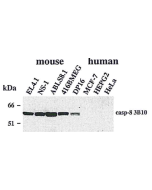Cookie Policy: This site uses cookies to improve your experience. You can find out more about our use of cookies in our Privacy Policy. By continuing to browse this site you agree to our use of cookies.
AdipoGen Life Sciences
anti-Caspase-8 (mouse), mAb (1G12)

| Product Details | |
|---|---|
| Synonyms | Apoptotic Cysteine Protease; Apoptotic Protease Mch-5; CAP4; FADD-homologous ICE/ced-3-like Protease |
| Product Type | Monoclonal Antibody |
| Properties | |
| Clone | 1G12 |
| Isotype | Rat IgG1κ |
| Immunogen/Antigen | Recombinant mouse caspase-8 (p20 subunit). |
| Application |
ELISA: (recombinant mouse caspase-8) |
| Crossreactivity | Mouse |
| Specificity |
Recognizes the p20 subunit of mouse caspase-8. Detects bands of ~55kDa (full-length caspase-8) and ~18kDa (apoptosis-induced cleavage fragment) by Western blot. Does not cross-react with human caspase-8. |
| Purity | ≥95% (SDS-PAGE) |
| Purity Detail | Protein G-affinity purified (sepharose column). |
| Endotoxin Content | <0.1EU/μg purified protein (LAL test; Lonza). |
| Concentration | 1mg/ml |
| Formulation | Liquid. In PBS containing 0.02% sodium azide. |
| Isotype Negative Control | |
| Shipping and Handling | |
| Shipping | BLUE ICE |
| Short Term Storage | +4°C |
| Long Term Storage | -20°C |
| Handling Advice |
After opening, prepare aliquots and store at -20°C. Avoid freeze/thaw cycles. |
| Use/Stability | Stable for at least 1 year after receipt when stored at -20°C. |
| Documents | |
| MSDS |
 Download PDF Download PDF |
| Product Specification Sheet | |
| Datasheet |
 Download PDF Download PDF |
Procaspase-8 belongs to the family of caspases. Binding of FasL to Fas leads to formation of a receptor complex at the cellular membrane, which was named DISC. The DISC consists of oligomerized receptors, the DD-containing adaptor molecule FADD, procaspase-8, procaspase-10 and c-FLIP. The DISC structure provides a platform for the oligomerization of procaspase-8 that allows two procaspase-8 homodimers to be in the close proximity leading to the initial activation of procaspase-8. At the first cleavage step, the N-terminal p43/p41 and the C-terminal p30 cleavage products are generated. Importantly, these cleavage products already possess catalytic activity. At the second cleavage step, p43/p41 and p30 are processed to p10 and p20, respectively, which leads to the generation of the active caspase-8 heterotetramer (p20/p10)2.
- Apaf-1 and caspase-9 do not act as tumor suppressors in myc-induced lymphomagenesis or mouse embryo fibroblast transformation: C.L. Scott, et al.; J. Cell Biol. 164, 89 (2004)
- Modifications and intracellular trafficking of FADD/MORT1 and caspase-8 after stimulation of T lymphocytes: L.A. O'Reilly, et al.; Cell Death Differ. 11, 724 (2004)
- Caspase-8 serves both apoptotic and nonapoptotic roles: T.B.Kang, et al.; J. Immunol. 73, 2976 (2004)
- Role of membrane sphingomyelin and ceramide in platform formation for Fas-mediated apoptosis: M. Miyaji, et al.; J. Exp. Med. 202, 249 (2005)
- Fatal Hepatitis Mediated by Tumor Necrosis Factor TNFα Requires Caspase-8 and Involves the BH3-Only Proteins Bid and Bim: T. Kaufmann, et al.; Immunity 30, 56 (2009)
- Catalytic activity of the caspase-8-FLIPL complex inhibits RIPK3-dependent necrosis: A. Oberst, et al.; Nature 471, 363 (2011)
- FLIP (Flice-like inhibitory protein) suppresses cytoplasmic double-stranded-RNA-induced apoptosis and NF-B and IRF3-mediated signaling: P. Handa, et al.; Cell Commun. Signal. 9, 16 (2011)
- XIAP restricts TNF- and RIP3-dependent cell death and inflammasome activation: M. Yabal, et al.; Cell Rep. 7, 1796 (2014)







